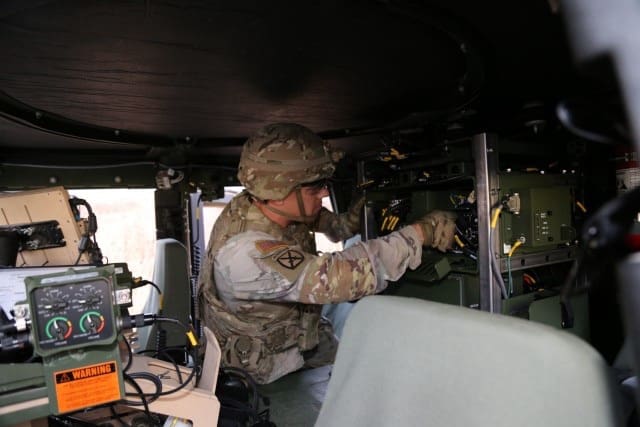
FORT RILEY, Kan. — In future operations, speed will equate to survivability, especially for armored formations — the Army’s most mobile and lethal force.
Commanders will need resilient high-capacity on-the-move (OTM) network connectivity, the foundation for mobile command and control (C2), to inform rapid decisions, swift maneuver and dispersed command post (CP) operations.
As part of the Army’s network transformation efforts, the service is preparing for the second phase of its Armored Formation Network (AFN) OTM Pilot, supported by the 1st Infantry Division, to inform the right combination of emerging commercial network technologies that best support these units and their fast-paced missions.
“This new equipment is providing a definite advantage,” said Lt. Col. Marreo Burch, senior division communications officer (G6) for 1st ID. “To give the commanding general and other senior leaders the ability to move around the battlefield and stay connected — especially with the adversary’s ability to detect the command post from just a sheer electromagnetic spectrum standpoint — increases our survivability [and lethality].”
The diverse set of emerging commercial AFN OTM and at-the-quick-halt pilot capabilities includes high-throughput low-latency satellite communications systems that operate in both geosynchronous and low Earth orbits. The kit also includes multi-band high-capacity line-of-sight (LOS) backhaul and mesh networking capabilities, commercial 5G LTE cellular, and secure Wi-Fi. Baseband systems include a Secure But Unclassified-Encrypted enclave to enable integration of Integrated Tactical Network data exchange.
Having the ability to leverage multiple transport options will not only enhance the unit’s operational flexibility but increase network resiliency, ensuring data can be exchanged in denied, degraded, intermittent, and low-bandwidth (DDIL) environments, including enemy jamming attempts.
“To be able to track the fight, not just over lower tactical internet [lower echelon radio-based networks], but now upper tactical internet (TI), on a digital common operational picture, and process all the information that comes in from those brigades, definitely provides the division commander and our senior leaders better visualization of the battlefield in large scale combat operations,” Burch said. “Instead of losing a major understanding of the battle moving from command post to command post, having that [upper TI] on-the-move keeps those commanders, those senior leaders, in the fight and provides [continual] battlefield circulation.”
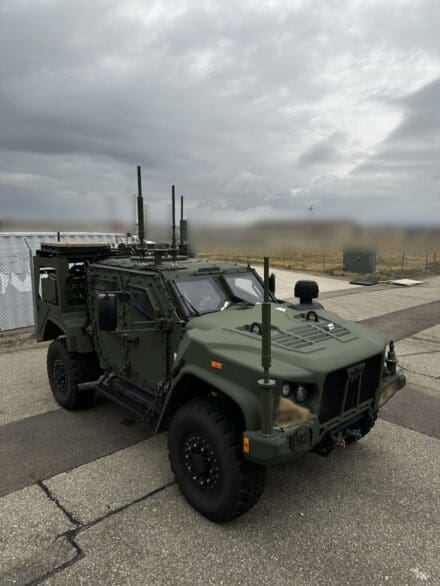
NETWORK CONNECTIVITY INSIDE VEHICLES
In preparation for the pilot, the Army’s Project Manager Tactical Network (PM TN) and Project Manager Interoperability and Services (PM I2S), at the Program Executive Office Command, Control, Communications, and Network (PEO C3N) — in tandem with other Army organizations including the C2 Cross Functional Team, Army Futures Command — partnered with industry to integrate a wide variety of new commercial OTM network capabilities onto the 1st ID’s Humvees and Joint Light Tactical Vehicles. The intent, however, is for the AFN design to be a modular kit that can be incorporated into other platforms, including Armored Multi-purpose Vehicles and Strykers. Because of this modularity, units will also be able to quickly install, replace, or add components that better serve specific mission sets. The equipment provides a significant size-weight and power reduction compared to current capabilities, which is critical for armored vehicle integration and increased command post mobility.
The AFN OTM equipment set includes advanced software capabilities such as the Army’s automatic primary, alternate, contingency and emergency (auto-PACE) communications capabilities that simplify bandwidth diversity for Soldiers in the fight. During the 1st ID command post exercise (CPX) at Fort Riley, in November, held in preparation for the upcoming pilot, Burch got a first-hand look at the auto-PACE capability as he conducted operations inside one of the integrated vehicles.
“During my 45-minute ride, when one transport was degraded, it would auto-switch to the lower latency mode of transport while we were moving,” he said. “It made sure that the highest, most efficient means of communication transport was selected. It definitely helped with maintaining comms while on the move.”
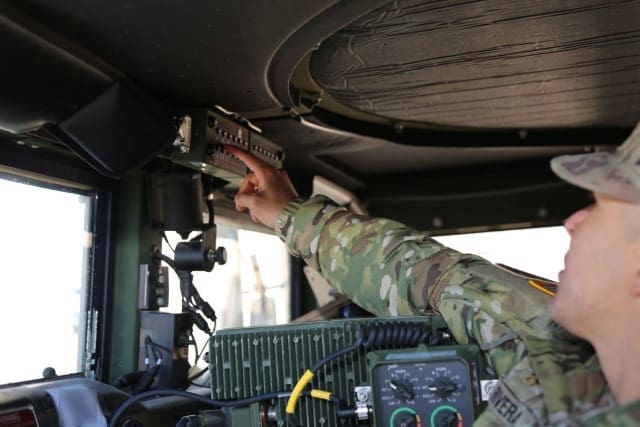
SUPPORTING NETWORK MODERNIZATION
The Army is leveraging lessons learned and Soldier feedback from the first phase of the AFN OTM pilot, conducted at Fort Stewart, Georgia, in January 2022, to implement phase two. This second phase will be supported by 1st ID Headquarters, Division Artillery Brigade and 1st Brigade Combat Team Headquarters, during the units’ combat training center rotations at the National Training Center, Fort Irwin, California, later in fiscal year 2025.
Learning from combat training rotations helps to ensure the Army maintains a competitive advantage over its adversaries, including fighting in DDIL environments, use of the electromagnetic spectrum, protected communications, cyber security, and distributed C2 at echelon.
During the AFN OTM Pilot phase two, Soldiers will evaluate solutions that are interoperable with the existing network, while providing a path to the future. Soldier feedback will inform decisions on enduring AFN OTM capability baseline and requirements using technologies that will also help shape other Army modernization efforts, such as command post modernization; C2Fix efforts that deliver simple, intuitive, mobile and lower signature solutions to current close-combat forces; and Next Generation C2 for future warfare.
Supporting the Army’s efforts to pull technical complexity up to division and above, the AFN OTM Pilot will evaluate the best distribution of networking capabilities within armored formations that provides value without over-burdening Soldiers at lower echelons.
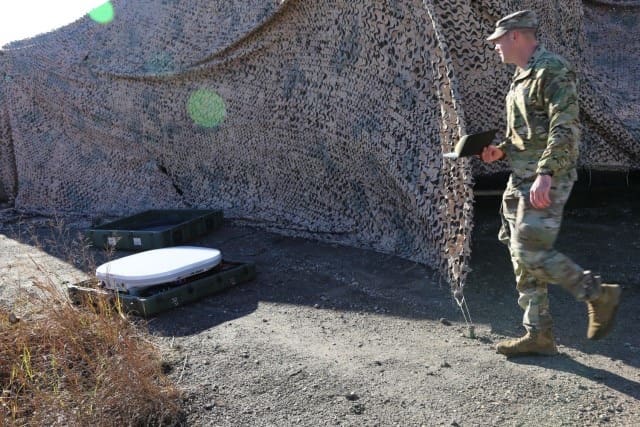
ENHANCING CP MOBILITY
To prepare for future large scale combat operations, the Army has ceased developing large, static command posts, opting instead for more mobile command posts with faster setup and teardown, and better ability to conduct distributed operations. The AFN OTM equipment set includes expeditionary at-the-quick-halt satellite systems that deliver high-throughput low-latency command post network connectivity in minutes, providing units with faster command post displacement and maneuver, greater operational flexibility, and increased survivability compared to legacy equipment. Additionally, an aerial layer leverages variable height antennas to extend high-capacity LOS range, overcome LOS terrain challenges such a tree canopies, or enable units to hide from detection.
“The speed at which the enemy can [identify] us once we turn on all of our equipment and systems is really our biggest challenge,” said Maj. Adam Black, deputy G6, 1st ID, from inside one of the integrated vehicles during the CPX.
The commercial AFN OTM baseline kit enables the unit to better conduct dispersed communications, or the ability to spread out the command post operations, “so we can fight a command post separated over a country’s distance rather than just in one spot,” Black said. “Inevitably, we are going to be under contact, and that is what we have to prepare for. If [we operate dispersed and] we lose a specific section of our CP, we won’t lose the entire CP.”
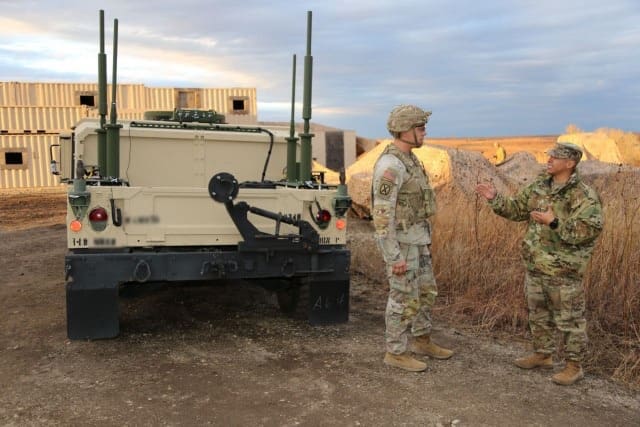
As the Army continues to move network complexity to division echelons and relevant emerging network technologies require more bandwidth, armored formations will need reliable upper TI OTM communication solutions to execute decentralized C2, which will enable commanders to make timely and informed decisions on the battlefield and outmaneuver the enemy.
“As an armored unit, our biggest issue historically has been being able to communicate on upper TI across the battlefield,” said Chief Warrant Officer 2 Justin Carrier, network technician, 1st ID. “Because of the amount and types of transport [in this kit], I have faith that we can retain some form of [upper TI] network transport in any type of disruptive environment.”
By Amy Walker, Project Manager Tactical Network, PEO C3N, public affairs

